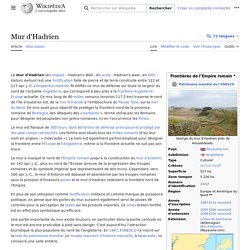

Reused as a door lintel @EHCarlisle this c213AD altar to Jupiter #hadrianswall #archaeology. Roman road unearthed during Hadrian's Wall car park work. Hadrian's Wall: Can it survive the 21st century? For 2,000 years Hadrian’s Wall has straddled the borderlands of northern Britain and withstood assault by Pictish tribes, its stones being nicked to build farmsteads, dubious 20th century reconstructions and being clambered upon by countless generations of curious tourists.

Last year its museums had more than a million visitors and 3.5 million people took a break in Hadrian’s Wall CountryBut now a mighty blow has come to this immense symbol of the power of the Roman Empire – courtesy of 21st century government funding cuts. This week the Hadrian’s Wall Trust will shut its doors after seven years in which it has spearheaded a transformation in the 120-mile long UNESCO World Heritage Site’s fortunes, reversing a 30-year decline in visitor numbers to make Hadrian’s Wall more popular than Stonehenge.
Last year its museums had more than a million visitors and 3.5 million people took a break in Hadrian’s Wall Country. “In 2006 the Wall was failing,” says Trust chief executive Linda Tuttiett. Mur d'Hadrien. Le mur est flanqué de 300 tours, dont 80 fortins de défense principales et protégé par dix-sept camps retranchés.

Les fortins sont situés tous les milles romains (d'où leur nom en anglais : « milecastle »). Le nom est également parfois employé pour désigner la frontière entre l'Écosse et l'Angleterre, même si la frontière actuelle ne suit pas son tracé. Le mur a marqué le nord de l'Empire romain jusqu'à la construction du mur d'Antonin, en 142 apr. J. -C., plus au nord de l’Écosse (preuve de la progression des troupes romaines et du symbole impérial que représentaient de tels murs). En plus de son utilisation comme fortification militaire et comme marque de puissance politique, on pense que les portes du mur auraient également servi de postes de contrôle pour la perception de taxes sur les produits importés. Une importante partie du mur existe toujours, en particulier dans la partie centrale, et le mur est encore praticable à pied sans danger. Who Built the Wall? A legion was around 5,000 heavily armed and armoured men who were, by the 2nd century AD, even more of an anachronism than the rams that still adorned the prow of every Roman warship in their fleets.

Organised into ten cohorts, each of around 480 men, they were extremely effective in open battle, especially when complemented by their attached auxiliaries. Legionaries (never, please, ‘legionnaires’) were nevertheless unsuitable for garrisoning a province and all-too-easily wrong-footed by even the most basic of insurgencies (as all technologically dependent armies tend to be). Britannia was to turn out to be a troubled (and troubling) place. It needed four legions until the end of the AD 80s and right up until the beginning of the 2nd century AD it still had three (II Augusta, IX Hispana, and XX Valeria Victrix). Then something happened, and at some point between AD 108 and 122 it was probably reduced to two, which was evidently not enough. Legio II Augusta Legio XX Valeria Victrix. 10 must see sites along Hadrian’s Wall HeritageDaily. These accolades are well deserved as along the wall you can discover a multitude of historical sites.

Hadrian’s Wall dates back 2000 years ago to the days of the emperor Hadrian, one of the Five Good Emperors to rule the empire. The wall exposes the beautiful northern landscape as well as ancient forts, ruined temples and historical towns. 1 Arbeia Roman Fort Arbeia Roman Fort is located in South Shields on the River Tyne and contains the only permanent stone-built granaries yet to be discovered in Britain.
Arbeia Roman Fort: WikiPedia The fort was constructed around AD160 and is a must-see because it is the only fort along Hadrian’s Wall where visitors have the opportunity to see the archaeologists at work. 2 Walls End Also known as Segedunum Walls End is located at the eastern end of the wall near the River Tyne. Walls End: Flickr Interestingly Walls End functioned as a garrison for 300 years. 3 Vindolanda. Days Out - Hadrian's Wall.
Hadrian's Wall is an epic World Heritage Site, marching 73 miles from sea to sea across some of the wildest and most dramatic country in England.

Experience Roman life and epic history in stunning locations. We have now switched to our winter opening hours, meaning that while many properties are open at weekends and are running events for all, there may be restricted access during the week. Please check opening times before travelling. Mur d' Hadrien : Le Mur : Comment ? Le Mur d'Hadrien .

Le Mur : comment ?. Le mur d'Hadrien s'étend sur environ 120 km, il commence à l'est de l'embouchure du fleuve Tyne (Newcastle) jusqu'au Solway Firth à l'ouest . Il traverse les plaines, les monts et les fleuves . Ce n'est que sur son tronçon central, fortement accidenté , qu'il est le plus impressionant . Sa construction initiale dura 6 ans, mais plusieurs sections furent remaniées par la suite (en particulier des tronçons en terre seront remplacés par des tronçons en pierre) . Le mur d’Hadrien : la plus grande frontière de l’empire Romain. Construit à partir de 122 après J.
